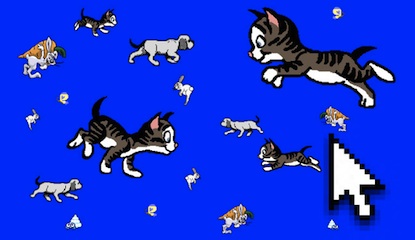
Clickistan may be the craziest thing I’ve seen recently. It’s an abstract online art game by Ubermorgen.com, which is also and simultaneously a promotional game for the Whitney Museum of American Art’s 2010 annual fund. The Whitney commissioned Clickistan, which they describe like this:
a work of computer game art that references early net art and classic coin-operated arcade games such as Space Invaders (1978), Donkey Kong (1981) and Pac Man (1980). As you move through levels, you’ll score points in ways that aren’t immediately obvious. The retro feel of the games will inspire the inner gamer in many, and for those visitors who are knowledgeable about the history of net art, the visit will be even more rewarding.
The game’s levels are inscrutable in a net art sort of way—in fact, the curator suggests that the work is “an homage to the net art of the mid-90s.” Personally, I find it less homage and more recapitulation, adopting all the wacky impenetrability of net art without any of the synthetic experience of more contemporary attempts at structured bewilderment (take Cactus’s Tuning as a counterpoint).
In that respect, the cynic might see Clickistan as nostalgia rather than homage, wistfulness for the “golden era” of net art. But at the same time, the game literally operates as a fundraising tool: once the player reaches the end, the game actively encourages contribution. So we can also interpret the game as a tool that undermines current traditions of digital art, particularly the traditions that galleries and museums like the Whitney have embraced (whether by choice, inertia, or politics). Perhaps Clickistan suggests a new openness to art games among the art world, a call to end the 1990s at long last. But, then again, perhaps not.
Comments
Greg J. Smith
I agree, it is hermetic â?? and I’m kind of at the point where I’m wondering if there is anything framed as ‘net art’ that *isn’t* nostalgic. I do love Clickistan as a fundraising lure and although the game is baffling it does invite people into the (oblique) space of the campaign. More than anything though, I really dig the sound design/music. Some of the material sounds like Atom Heart â?? I really need to track this stuff down.
Mark N.
The way the core of the piece is based on “misusing” input widgets like radio buttons and drop-down boxes — which get moved around, cause changes that the widget normally wouldn’t cause, etc. — reminds me of a certain genre of Hypercard art. (I’m not sure it even originated there, but that’s where I first encountered it.)
Ian Bogost
Greg, according to the Whitney site, the music is care of micromusic.net. I suppose it should come as no surprise that the most delightful part of the work is one its creators didn’t fashion. Wait, did I say that out loud?